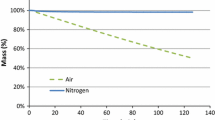Abstract
Sixty years of experience in manufacture of fibres from acrylonitrile polymers and copolymers suggest favorable prospects for the development of this kind of textile stock. The characteristics of the primary and supermolecular structure of this class of fibre-forming polymers, the ability to widely vary the methods of converting them into the viscous-flow state, and the methods of spinning, orientational drawing, modification and thermal fixation treatments form the technological base for creation of PAN fibres with defined properties. The basic trends in scientific and technical progress in development of production (volumes and assortment) of PAN fibres are: increasing the unit capacities for production of large-tonnage assortments of fibres while minimizing power and materials consumption; creating multivariant production lines to manufacture fibres for special applications and with specific performance characteristics; increasing the economy of production while minimizing environmental pressure. The important prospects for expanding the areas of application of PAN fibres are due to the reactivity of the functional groups in the polymer substrate. Industrial implementation of technologies based on polymer-analog transformations will allow creating new kinds of materials for use in industry, agriculture, and construction and for data collection, storage, and transfer.
Similar content being viewed by others
REFERENCES
Fiber Organon, No. 6, 95 (2001).
H. F. Mark, Polymers to the Year 2000 and Beyond. A Forecast, (February, 1987) (private communication).
H. F. Mark, Chem. Eng. Prog., No. 6, 44–54 (1987).
H. Rein, Z. Angew. Chem., 60, 159–165 (1948); 61, 241–246 (1949); Patent No. BRD 915034.
R. C. Houtz, Res. Text. J., 20,No. 11, 786–791 (1950); USA Patent No. 2404720, 2404724, 2404717 (07.23.46); 2404721, 2404717, 2404727 (07.26.46).
R. Hill (ed.), Fibres from Synthetic Polymers, Elsevier, Amsterdam-Houston-New York-London (1953).
A. B. Pakshver and B. E. Geller, Nitron Fibre Production Chemistry and Technology [in Russian], Goskhimizdat, Moscow (1960).
L. A. Vol'f (ed.), Fibres with Special Properties [in Russian], Khimiya, Moscow (1980).
V. E. Kotina, A. A. Konkin, and R. M. Kosova, USSR Inventor's Certificate No. 13824 (1959).
A. A. Konkin, Carbon and Other Heat-Resistant Fibre Materials [in Russian], Khimiya, Moscow (1974).
B. E. Geller, S. P. Matveeva, and A. B. Pakshver, Nauchn. Dokl. Vyssh. Shkoly, Ser. Khim. Khim. Tekhn., No. 3, 553–558 (1958).
A. A. Geller and B. E. Geller, Khim. Volokna, No. 3, 8–17 (1990).
Ch. Fryer, Chem. Fibers Intern., 51,No. 6, 184–187 (2001).
B. E. Geller, Doctoral Dissertation, Tashkent Textile Institute, Tashkent-Leningrad (1964).
M. Yu. Kirgizbaeva and B. E. Geller, Khim. Volokna, No. 5, 39–40 (1981).
G. M. Gantz, Am. Dyestuff Rep., 41, 100, 116 (1952).
N. Yu. Shirshova, M. Yu. Mukhamedzhanova, and T. Khamrakulov, Khim. Volokna, No. 1, 3–5 (2001).
J. Mayima, N. Masui, et al., Japanese Patent No. 147451, 5/S (1940).
H. Rein, USA Patent No. 2117210, 2140921.
E. A. Pakshver, Zh. Vses. Khim. O-va im. D. I. Mendeleeva, 17,No. 6, 644–647 (1972).
E. A. Pakshver, in: Carbon-Chain Fibres [in Russian], K. E. Perepelkin (ed.), Khimiya, Moscow (1973), pp. 7–163.
B. E. Geller, Khim. Volokna, No. 6, 3–7 (1997).
K. Engel, Chemiefasern/Textilindustrie, 33/85,No. 9, 546–549 (1983).
Yu. M. Malyshev, A. A. Geller, et al., Khim. Volokna, No. 3, 24–25 (1985).
Yu. M. Malyshev and B. E. Geller, Khim. Volokna, No. 6, 41–43 (1993).
H. Schulz, Chemiefasern/Textilindustrie, 42/94,No. 12, 964–968 (1992).
A. T. Serkov, L. A. Zlatoustova, and M. B. Radishevskii, Khim. Volokna, No. 3, 16–20 (2000).
A. L. Kalabin and E. A. Pakshver, Khim. Volokna, No. 4, 38–41 (2000).
A. L. Kalagbin and E. A. Pakshver, Khim. Volokna, No. 1, 12–14 (2001).
M. Pinton, Chem. Fibers Intern., No. 4, 298–300 (1996).
R. Cox, Man-Made Fiber Year Book, No. 8, 32–34 (2001).
F.-G. Nimts, A. A. Geller, and B. Kh. Yunusov, Khim. Volokna, No. 3, 11–13 (1986).
A. A. Geller, Candidate Dissertation, Tashkent-Leningrad (1963).
D. N. Akbarov, Khim. Volokna, No. 1, 18–20, 20–22 (1990).
Zh. A. Zgibneva, A. A. Geller, et al., Khim. Volokna, No. 6, 51–53 (1973).
K. E. Perepelkin, Khim. Volokna, No. 5, 3–16 (2000); No. 6, 3–13.
I. Z. Zakirov, Physical Modification of Polyacrylonitrile Fibre [in Russian], FAN, Tashkent (1982).
I. Z. Zakirov and B. E. Geller, Khim. Volokna, No. 4, 12–14 (1992).
A. I. Yamamoto, Khim. Tekhnol. Polim., No. 4, 141–148 (1964).
I. Z. Zakirov, Candidate Dissertation, Tashkent Institute of Textile and Light Industry, Leningrad (1968).
B. Von Falkai, Chem. Fibers Int., 50,No. 2, 144–150 (2000).
I. Z. Zakirov, B. E. Geller, and G. N. Babenko, Dep. VINITI, No. 1142 (1976).
Kh. N. Muratova, R. I. Danilova, et al., in: Current Problems in Modern Medicine [in Russian], Tashkent (1974), p. 200.
E. N. Zil'berman, Reactions of Nitriles [in Russian], Khimiya, Moscow (1972).
Author information
Authors and Affiliations
Rights and permissions
About this article
Cite this article
Geller, B.E. Status and Prospects for Development of Polyacrylonitrile Fibre Production. A Review. Fibre Chemistry 34, 151–161 (2002). https://doi.org/10.1023/A:1020525628197
Issue Date:
DOI: https://doi.org/10.1023/A:1020525628197




